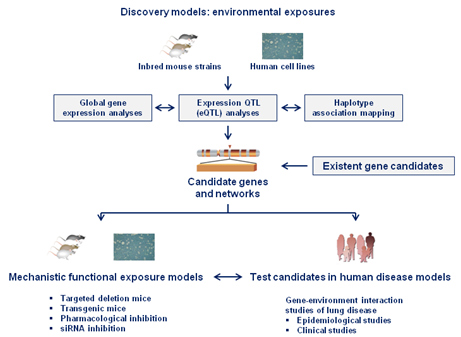Genetic Susceptibility in Lung Disease
-

-
Steve Kleeberger, Ph.D. (Retired)
Special Volunteer -
Tel 984-287-4082
[email protected]
Research Summary
Steven R. Kleeberger, Ph.D., is a Special Volunteer in the Environmental Genetics Group and holds secondary appointments in the NIEHS Genome Integrity and Structural Biology Laboratory and the NIEHS Clinical Research Branch.
Genetic background has an important role in susceptibility to complex lung diseases such as asthma, chronic obstructive pulmonary disease (COPD), and acute respiratory distress syndrome (ARDS), and the genetic contribution to disease phenotypes varies between populations. Interaction between genetic background and exposures to environmental stimuli, and understanding the mechanisms through which environmental exposure interact with susceptibility genes, are critical to disease prevention. Animal models, particularly inbred mice, have provided important insight to understand human disease etiologies because genetic background and environmental exposures can be controlled. Tools including in silico haplotyping, collaborative cross and diversity outcross mouse panels, bioinformatic applications, and -omics technologies have enhanced our ability to identify disease genes and pathways to guide translational investigations that apply these discoveries to human populations. Combined genetic and genomic approaches have yielded important insight to mechanisms of susceptibility to many complex traits and diseases.
The environmental genetics group (EGG) has focused efforts to understand the role of genetic background as a susceptibility factor in the pulmonary effects of environmental stimuli. We have integrated inbred mouse and cell-based models with haplotype association mapping (genetic), global gene expression analyses (genomic), and expression quantitative trait locus mapping (eQTL or genetical genomics) to identify candidate susceptibility genes and associated gene networks. These and existent gene candidates have been evaluated mechanistically in the models using a battery of tools and approaches (Figure 1). The overarching goal of these investigations is to determine whether human homologues of these susceptibility genes associate with disease risk in human populations. Efforts to identify and validate susceptibility genes in mouse models of environmental disease with a goal towards translational application will enable identification of individuals who are susceptible to disease and may lead to novel intervention or therapeutic strategies to prevent disease.

Clinical Research
The group wants to understand oxidant stress responses and identify and assess candidate genetic markers for risk of specific disease states as a function of exposures to oxidative stressors, and the strength of interaction between the genotype and the agent. To this end, we also plan to evaluate (in parallel and in the future) the role of candidate oxidant susceptibility genes that we’ve identified and characterized in additional diseases (e.g. COPD, atherosclerosis, asthma) in which oxidant stress is suspected or known to be important in etiology.
Major areas of research:
- Ozone(O3)-induced Pulmonary Injury and Inflammation
- Mechanisms of Respiratory Syncytial Virus (RSV) Infection and Disease Severity
- Mechanisms of Susceptibility to Hyperoxia-induced Lung Injury in Adults and Neonates
Kleeberger earned his A.B. in zoology at Miami University (Oxford, OH), and his Ph.D. in ecology and environmental physiology at Kent State University (Kent, OH). He holds Adjunct Professorships at Duke University (Medicine) and the University of North Carolina at Chapel Hill (Medicine). He has published over 140 peer-reviewed articles in leading biomedical journals as well as two dozen book chapters and invited reviews. Kleeberger was a professor of environmental health sciences at the Johns Hopkins Bloomberg School of Public Health before joining NIEHS in 2002.
He is a reviewer for over 20 journals, and he has been on the editorial board a number of journals, including Pharmacogenetics, Environmental Health Perspectives, and The American Journal of Respiratory and Critical Care Medicine. He was Chief of the Laboratory of Respiratory of Biology (LRB) from 2002-2010, and Acting Deputy Director of NIEHS from 2009-2011. Kleeberger has given over 100 invited lectures in the United States, Europe, Asia and South America. He has been president of the Inhalation Specialty Section of the Society of Toxicology, and has also served or currently serves on multiple study sections at the National Institutes of Health, international advisory committees on genetic susceptibility, and Clean Air Scientific Advisory Committee (CASAC) Review Panels.


